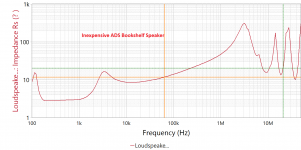Most of the time it looks generic unbranded but it would be OFC and of good quality. If it is not made for audio, it will usually cost several times cheaper and might have better performance than msot audio cables. Military grade ones come to mind. Besides, as noted above, using 3m of $$$/m cable will eventually get you to the crossover where a 0.6mm coil made of solid core wire with length of 15-20m will be present, on most of the cheaper loudspeakers (that if you`re lucky for it to be an aircore).
The length of 'skinny' connecting wire inside a speaker cabinet is so short that it introduces an insignificant amount of resistance to the flow of current.
It is in the longer run between the amplifier and the speaker where the benefits of using a thicker wire to reduce resistance are obtained.
Using too thick a wire internally can cause problems in crimping or soldering the thick wire to the driver terminals as well as putting undue stress on the terminals due to the weight of the cable.
It is in the longer run between the amplifier and the speaker where the benefits of using a thicker wire to reduce resistance are obtained.
Using too thick a wire internally can cause problems in crimping or soldering the thick wire to the driver terminals as well as putting undue stress on the terminals due to the weight of the cable.
...oh yes, those EMF activitiesThe cable should be a closely spaced twisted pair or quad
...the wire in the speaker box is just some skinny thing...
Cut up a loudspeaker and unwind the voice coil. That wire is long and SKINNY!!
You do need "better" wire TO the speaker so that the voice coil gets most of the power. But 15 feet of lampcord, or 2 feet of hookup wire, is not a big deal compared to the speaker guts.
DC Cable Sizing Tool - Ensure You Use The Correct Sized Cables - Free Calculator
calculate dc cable thickness for length. not sure if its the right calculator for speakers.... but you can get an idea. see for ya self. why very short thin cable is ok inside speaker but depending on ohms of speaker and length, you need may need thick cable to connect speaker to amp.
calculate dc cable thickness for length. not sure if its the right calculator for speakers.... but you can get an idea. see for ya self. why very short thin cable is ok inside speaker but depending on ohms of speaker and length, you need may need thick cable to connect speaker to amp.
For speaker cables thick is about the only good thing. However, beyond a certain point you enter diminishing returns so too thick has no real electrical advantage and may have mechanical disadvantages.planet10 said:Thick is not necessarily a good thing.
The system consists of essentially a simple circuit loop. You want to minimise the resistance by using thick enough conductors, and minimise the inductance by keeping the out and return conductors near each other.Amps. speaker and what connects them has to be considered as a system.
There are difficult bits in audio. Speaker wire is not one of them.
Do you mean 24awg? If that's the case then it would probably be adequate if you used low power and the amplifiers were very close to the speakers.I use solid core 24g from the amp to the speaker (and inside the speaker)
If I may, while as a broad principle I absolutely agree with the points made above, Dave is also correct within certain contexts. For example, many (not all) Fostex drive units are overdamped assuming a more-or-less pure voltage source and were specifically designed to be used with high output impedance amplification. This is not a matter of conjecture: the man who was one of the lead designers on the old 'FExx6E' series drive units confirmed it when we met in Hong Kong a couple of years ago. Ergo, if your amplifier is inappropriate to the design intentions (output impedance in the approximate 1.5ohm - 3ohm region), then some series R, either with a fixed resistor or the distributed resistance of a narrow gauge wire / more resistive conductor will compensate. This is a somewhat restricted variation on the early days of high fidelity, when many amplifiers had adjustable output impedance to help optimise the electrical & acoustical system alignment.
Yes twisted pairs. Speaker cables can act as RF interference antennas. The interference sneaks in thru the feedback network to the input stage. It's something that Jim Brown sometimes writes about....oh yes, those EMF activities
Unless you're running kilowatt power levels into 2R speakers, this is all you need:
Pyramid RSW12100 12 Gauge 100 Feet Spool of High Quality Speaker Zip Wire: Amazon.ca: Gateway
Pyramid RSW12100 12 Gauge 100 Feet Spool of High Quality Speaker Zip Wire: Amazon.ca: Gateway
Some of the better speaker cable I have used was some surplus commercial aircraft power cable. It was wound (twisted within the casing) to help reduce rf emission for it’s intended application.
I still have some but it’s not very practical to use, is very stiff and isn’t a pair.
I just use 16awg lamp cord.
I still have some but it’s not very practical to use, is very stiff and isn’t a pair.
I just use 16awg lamp cord.
The best speaker wire I ever used, went direct from the amp to the speaker with little detouring, and had clean contacts.
Life is easy if you think lamp cord because no one can hear the difference with the boutique cables and if they do it's because of a problem with them, not the lamp cord.
Stop sweating what the SO'ers tell you.
Life is easy if you think lamp cord because no one can hear the difference with the boutique cables and if they do it's because of a problem with them, not the lamp cord.
Stop sweating what the SO'ers tell you.
Fully agree, often needed so your grandchildren can actually have a Dad who takes care of them:It definitly does not hurt to own a 12gauge

...oh yes, those EMF activities
Get out your antenna physics handbook. As Cordell writes "EMI Ingress: Antennas Everywhere" When you get into the MHz the cable, even connected to a loudspeaker, acts as a badly terminated radiator.
Attachments
If connecting speakers in an average room, a length from 3 to 20 feet, standard 16 gauge copper "zip cord" is fine, unless somebody on the internet has scared you into using some kind of nutty expensive wire that you really don't need.
And there are tons of "snake oil" salesmen on the internet and even in stores - they need your money.
And there are tons of "snake oil" salesmen on the internet and even in stores - they need your money.
- Home
- Design & Build
- Parts
- Speaker wire
